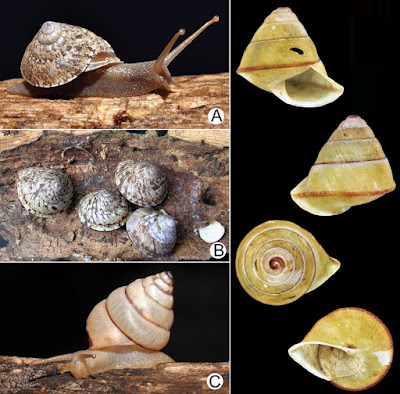Abstract
The taxonomy of the speciose genus Ganesella W.T. Blanford, 1863 and the endemic genus Globotrochus Haas, 1935 is unclear since the anatomical characters of the the type species of these two genera have never been reported before. Therefore, the present paper provides the first anatomical descriptions of the reproductive apparatus, pallial system and radula of Helix capitium Benson, 1848 and Helix onestera Mabille, 1887, the respective type species of Ganesella and Globotrochus. In addition, Ganesella rhombostoma (Pfeiffer, 1861) and Ganesella carinella (Möllendorff, 1902) from Thailand are re-described, and a new species, Ganesella halabalah Sutcharit & Panha, sp. nov., from southern Thailand is described. This new species differs from all others by having a larger shell, an obtuse apex and an aperture lip with a prominent beak-like deflection.
Keywords: anatomy, Cerastidae, Indochina, Orthurethran, Southeast Asia, synonym, systematics, tree snail
Ganesella halabalah Sutcharit & Panha, sp. nov.
Diagnosis: The dextral, large, trocoid shell with pale green to yellow colour, obtuse apex and apertural lip with prominent beak-like deflection.
Etymology: The specific name is derived from the type locality Hala-Bala Wildlife Sanctuary, Narathivat, Thailand.
Distribution: This new species is currently known from the type locality (in Narathivat, Thailand) and Gunung Tahan, Kelantan, Malaysia, which is about 150 km south of the type locality. The latter shell (Fig. 4C) was collected in 1901 in a tropical rain forest. This shell is in all aspects identical to the unique name-bearing type.
Remarks: Even though Ganesella halabalah sp. nov. is described from empty shells, its unique features mean that it cannot be confused with any other camaenid species from the area. Yet, with its trochoid shell and its prominent, beak-like apertural rostrum, G. halabalah sp. nov. does resemble a Papuininae phenotype. However, the geographic distribution of the Papuininae is largely restricted to New Guinea, Australia and Melanesia (Schileyko 2003), though excluding the Greater Sunda Islands and Indochina. Given that the Malay Peninsula is a remote area for land snail dispersal between Australasia and Indochina (Hausdorf 2000), further anatomical and molecular evidence is needed to assess an eventual relationship with Papuininae.
....
Chirasak Sutcharit, Thierry Backeljau and Somsak Panha. 2019. Re-description of the Type Species of the Genera Ganesella Blanford, 1863 and Globotrochus Haas, 1935; with Description of A New Ganesella species from Thailand (Eupulmonata, Camaenidae). ZooKeys. 870: 51-76. DOI: 10.3897/zookeys.870.36970







